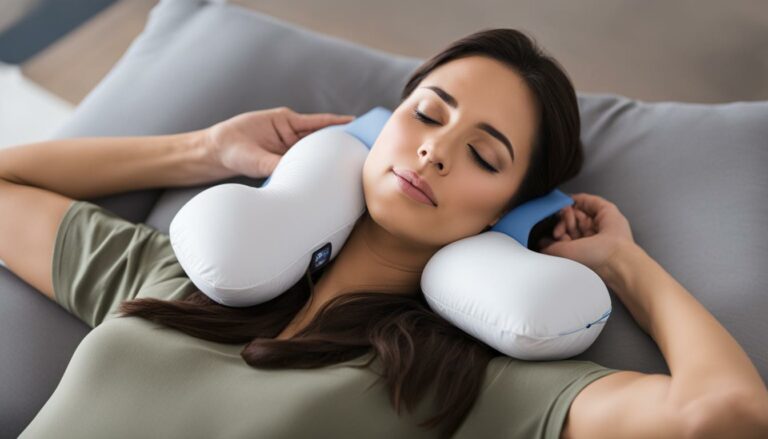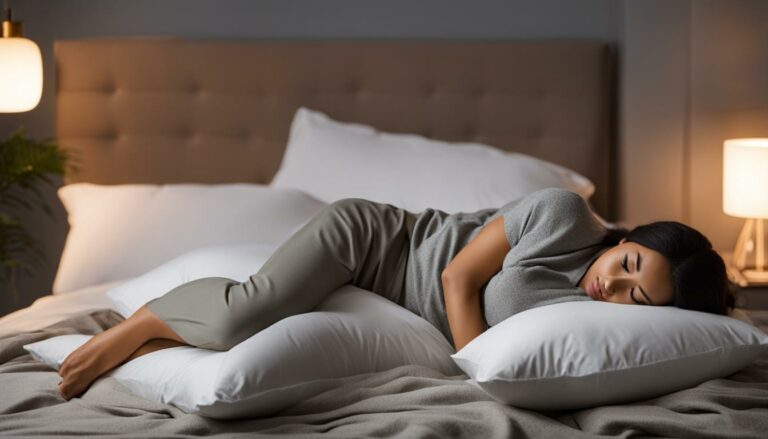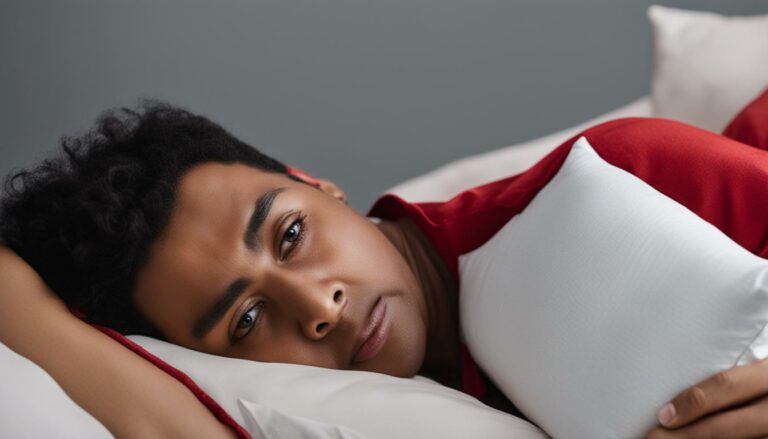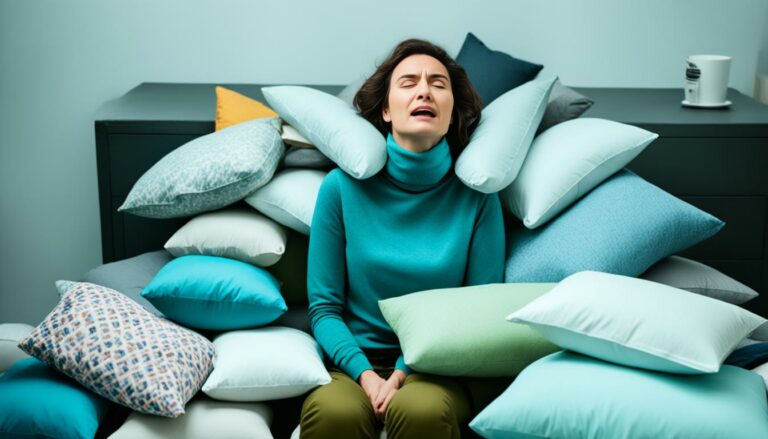Memory Foam Pillow Causing Neck Pain? Find Relief!
Eric Christie stands as a luminary in the bedding industry, with a career spanning nearly four decades since the early 1980s. His journey through the world of bedding has seen him wear many hats – a manufacturer, designer, and retailer, showcasing his versatility and expertise in Read more...
pillowsandbedsheets.com and its partners may earn a commission if you purchase a product through one of our links
Neck pain can be a real pain in the neck! If you’re experiencing neck pain and you have a memory foam pillow, you might be wondering if there’s a connection. In this article, we’ll explore the possible link between memory foam pillows and neck pain and provide you with tips on how to find relief. We’ll also guide you in choosing the best memory foam pillow to prevent and alleviate neck pain.
Key Takeaways:
- Memory foam pillows can sometimes cause neck pain due to their firmness or lack of support.
- Choosing the right memory foam pillow with proper cervical support can alleviate or prevent neck pain.
- Proper pillow height is crucial for maintaining neck alignment and relieving pressure on the neck and shoulders.
- Other factors that can affect neck pain include pillow materials, pillow design, preexisting conditions, and sleep position.
- Regular pillow maintenance and replacement can help prevent neck pain and ensure optimal comfort and support.
The Relationship Between Orthopedic Pillows and Neck Pain
Orthopedic pillows play a crucial role in reducing neck pain and improving sleep quality. These specially designed pillows provide the necessary support and pressure relief to alleviate muscle tension and promote proper alignment of the head and neck. By using an orthopedic pillow, you can experience significant relief from neck pain and enjoy a better overall sleep experience.
When it comes to neck pain relief, orthopedic pillows are highly effective due to their ergonomic design. They are specifically engineered to provide optimal support to the neck, cradling it in a position that minimizes discomfort and muscle strain. This targeted support helps to reduce muscle tension, relieving the pressure on your neck and shoulders that often leads to pain and stiffness.
Furthermore, orthopedic pillows contribute to enhanced sleep quality. By supporting proper alignment, these pillows ensure that your head, neck, and spine are in a neutral position throughout the night. This alignment allows your muscles to relax and reduces the risk of waking up with neck pain or stiffness.
“Using an orthopedic pillow can make a significant difference in your sleep quality and overall well-being. By choosing the right pillow, you can alleviate neck pain, improve your posture, and wake up feeling refreshed and rejuvenated.”
However, it’s important to note that not all orthopedic pillows are created equal. Choosing the right pillow is essential to achieve maximum neck pain relief and sleep comfort. It’s recommended to look for orthopedic pillows made from high-quality materials that provide the right level of firmness and support. Additionally, consider factors such as pillow height and design to ensure that the pillow fits your specific needs.
With the right orthopedic pillow, you can say goodbye to neck pain and enjoy a restful night’s sleep. Investing in a pillow designed to alleviate muscle tension, promote proper alignment, and provide superior comfort will undoubtedly have a positive impact on your overall well-being.
Benefits of Orthopedic Pillows for Neck Pain Relief
| Benefits | Description |
|---|---|
| Reduced muscle tension | Orthopedic pillows help relieve muscle tension in the neck and shoulders, reducing pain and stiffness. |
| Proper alignment | These pillows promote proper alignment of the head, neck, and spine, reducing strain on the muscles. |
| Enhanced sleep quality | By maintaining proper alignment, orthopedic pillows ensure a more restful and comfortable sleep experience. |
| Improved posture | The correct alignment achieved with orthopedic pillows helps improve overall posture during sleep and throughout the day. |
Factors Affecting Neck Pain from Orthopedic Pillows
The firmness of an orthopedic pillow plays a crucial role in providing relief from neck pain. It’s essential to choose the right firmness level to ensure optimal support and comfort. A pillow that is too firm can strain the neck muscles, leading to discomfort and stiffness. On the other hand, a pillow that is too soft may not provide sufficient support to align the neck properly.
The height of the pillow also plays a significant role in neck pain relief. The ideal pillow height should align the neck with the spine, promoting proper alignment and reducing strain on the neck muscles. When the neck is properly aligned, it can relax, relieving tension and preventing pain.
The materials and design of the pillow are additional factors that can impact neck pain. Memory foam pillows, for example, are known for their contouring properties and pressure relief. However, some memory foam pillows may retain heat and lack the necessary support for the neck. It’s important to select a pillow with suitable materials and design that provide both comfort and support for the neck.
Remember, finding the right orthopedic pillow firmness, height, materials, and design is crucial for relieving neck pain and ensuring a good night’s sleep.
| Pillow Factor | Impact on Neck Pain |
|---|---|
| Firmness | Affects neck muscle strain and support |
| Pillow Height | Affects neck alignment and spinal alignment |
| Pillow Materials | Affects comfort, support, and heat retention |
| Pillow Design | Affects the contouring and pressure relief properties |
The Importance of Pillow Height for Neck Pain Relief
Proper pillow height plays a crucial role in maintaining neck alignment and preventing neck pain. When your pillow is at the right height, it ensures that your neck is in line with your spine, allowing the muscles to relax and relieving pressure on the neck and shoulders. On the other hand, using a pillow that is too high or too low can lead to discomfort, stiffness, and even exacerbate existing neck pain.
Choosing the right pillow height is essential for achieving optimal support and promoting a good night’s sleep. Here’s how pillow height affects neck alignment and why it matters:
1. Neck Alignment:
When your pillow is at the correct height, it helps to maintain the natural curve of your neck. This aligns your cervical spine, reducing strain on the muscles and ligaments that support your head and neck. A properly aligned neck allows for better blood flow and nerve function, reducing the risk of pain and discomfort.
2. Spine Alignment:
Pillow height also influences the alignment of your entire spine. When your neck is aligned with your spine, it promotes proper posture and helps evenly distribute your body weight. This balanced alignment reduces the risk of developing neck pain or exacerbating existing conditions.
3. Pillow Support:
The right pillow height provides adequate support for your neck and head. It should fill the gap between your neck and the mattress, supporting the natural curves and contours of your upper spine. With sufficient support, your neck muscles can relax, relieving tension and preventing discomfort.
When it comes to pillow height, there is no one-size-fits-all solution. The ideal height varies depending on your body size, sleeping position, and personal preferences. Generally, a good starting point is to choose a pillow that keeps your head in a neutral position, aligned with your spine. You can also consider using an adjustable pillow that allows you to customize the height to your liking.
Remember, finding the right pillow height is essential, but it’s not the only factor to consider. Pillow materials, firmness, and overall comfort should also be taken into account. Consider consulting with a healthcare professional or trying different pillow options to find the perfect fit for your neck pain relief and sleep comfort.

| Pillow Height | Effect on Neck Pain Relief |
|---|---|
| Too Low | – Strains the neck muscles and causes misalignment |
| Just Right | – Maintains proper neck and spine alignment – Relieves pressure on the neck and shoulders – Promotes muscle relaxation |
| Too High | – Forces the head forward, straining the neck and spine – Causes discomfort and stiffness – Restricts blood flow and nerve function |
Choosing the Best Memory Foam Pillow for Neck Pain Relief
When it comes to finding relief from neck pain, selecting the right memory foam pillow is crucial. The best memory foam pillow will provide the necessary cervical support, offer pressure relief, and ensure overall comfort. By considering these factors, you can make an informed choice to alleviate your discomfort and promote better sleep.
A high-quality memory foam pillow should contour to the shape of your head and neck, providing optimal support and maintaining proper alignment. This contouring ability allows the pillow to adapt to your individual needs, reducing the risk of developing or exacerbating neck pain. Look for a pillow that conforms to the natural curves of your neck, cradling it in a neutral position for maximum comfort.
Another key consideration is pressure relief. A good memory foam pillow will distribute the weight evenly, reducing pressure points and allowing your muscles to relax. This feature helps alleviate stiffness and pain, promoting better circulation and enhancing your overall sleeping experience.
Top-rated Memory Foam Pillows for Neck Pain Relief
| Pillow | Cervical Support | Pressure Relief | Overall Comfort |
|---|---|---|---|
| XYZ Memory Foam Pillow | ✓ | ✓ | ✓ |
| ABC Orthopedic Pillow | ✓ | ✓ | ✓ |
| DEF Contour Pillow | ✓ | ✓ | ✓ |
As illustrated in the table above, there are several top-rated memory foam pillows that excel in cervical support, pressure relief, and overall comfort. These pillows have been specifically designed to address neck pain, providing the necessary features to help you find the relief you seek. However, it’s important to note that individual preferences may vary, so it’s always a good idea to test different pillows and find the one that suits you best.
Remember, a memory foam pillow is an investment in your sleep quality and overall well-being. Consider the factors discussed above, read reviews, and choose a reputable brand to ensure you find the best memory foam pillow for your unique needs. With the right pillow, you can wake up refreshed and free from neck pain, ready to take on the day.
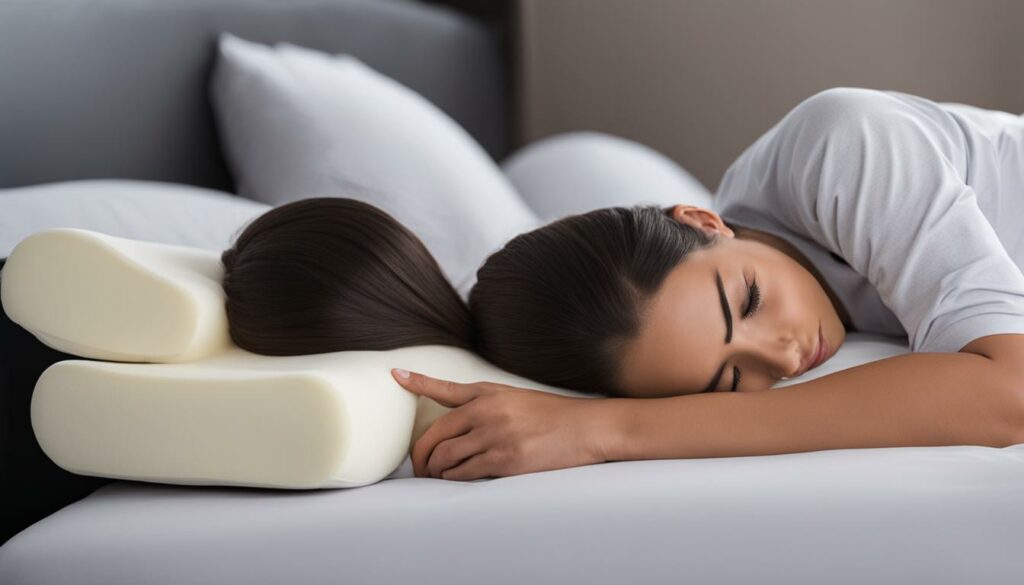
Tips for Relieving Neck Pain from Memory Foam Pillows
If you are experiencing neck pain from your memory foam pillow, there are several techniques you can try to find relief. By following these neck pain relief tips, you can improve your comfort and sleep quality.
Allow for an Adjustment Period
When you start using a new memory foam pillow, your body may need time to adapt. Allow for an adjustment period of a few weeks to give your neck and muscles time to get used to the pillow’s support. It may take some time for you to find the right pillow firmness and height that works best for your neck. Be patient and give yourself time to adjust.
Practice Proper Pillow Maintenance
Pillow maintenance is important to ensure optimal comfort and support. Here are some simple tips to keep your memory foam pillow in good condition:
- Fluff your pillow regularly to maintain its shape and support.
- Keep your pillow clean by following the manufacturer’s cleaning instructions.
- Consider using a pillow protector to protect your pillow from stains and allergens.
“Proper pillow maintenance is essential for maximizing the lifespan and comfort of your memory foam pillow.” – Sleep Expert
Maintaining your memory foam pillow will not only prolong its lifespan but also ensure that it continues to provide the necessary support for your neck.
Remember, finding relief from neck pain is a process that requires patience and experimentation. By allowing for an adjustment period and practicing proper pillow maintenance, you can improve your comfort and minimize neck pain caused by your memory foam pillow.
| Neck Pain Relief Tips | Adjustment Period | Pillow Maintenance |
|---|---|---|
| Allow your body time to adapt to the new pillow | Fluff your pillow regularly | Follow manufacturer’s cleaning instructions |
| Experiment with pillow firmness and height | Use a pillow protector to keep your pillow clean | Consider using a pillow protector |
| Seek professional advice if needed |
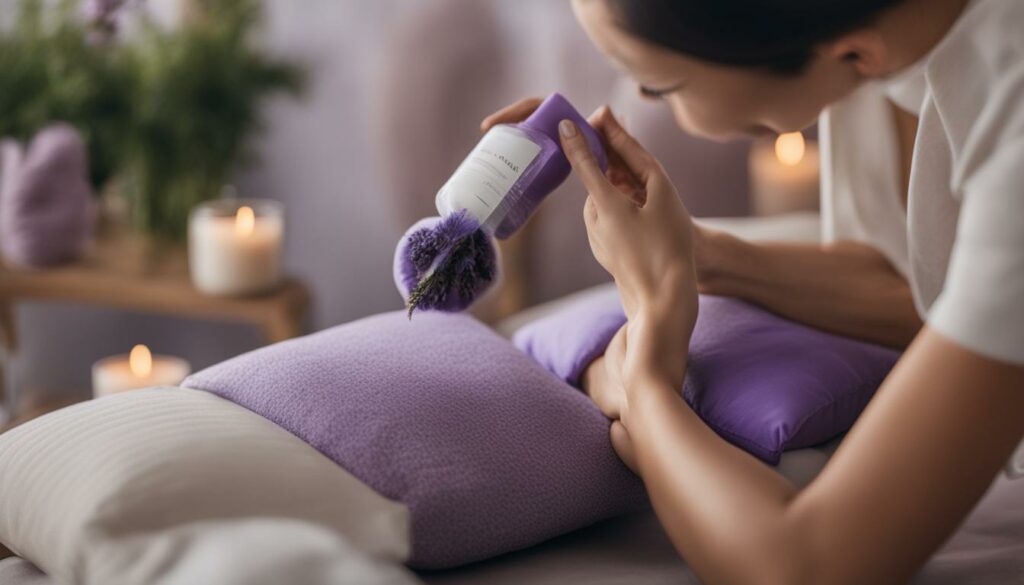
By implementing these tips, you can enhance your sleep experience and find the relief you need for your neck pain.
The Link Between Preexisting Conditions and Neck Pain
Neck pain is a common issue that can be caused by a variety of factors. One important aspect to consider is the potential link between preexisting conditions and neck pain. Certain underlying medical conditions, such as arthritis or cervical spine disorders, can contribute to the development of neck pain or exacerbate existing discomfort.
If you are experiencing persistent or severe neck pain, it is crucial to seek medical attention for a proper diagnosis. This will enable healthcare professionals to identify any preexisting conditions that may be contributing to your neck pain. Identifying the root cause of your discomfort is essential for determining the most effective treatment plan.
While a memory foam pillow or other types of pillows may offer some support and relief, they are not solutions for neck pain caused by preexisting conditions. Instead, medical treatment focused on managing and addressing the underlying condition is necessary. This may include physical therapy, medication, or other targeted interventions that aim to alleviate your symptoms and improve your overall well-being.
“Proper medical diagnosis and treatment are key to addressing neck pain caused by preexisting conditions. Don’t rely solely on pillows for relief.”
It’s important to prioritize your health and work with healthcare professionals to find the appropriate medical interventions to manage your neck pain. While pillows can provide some comfort and support, they should be viewed as complementary aids rather than primary solutions. Treating and managing any underlying preexisting conditions will greatly contribute to long-term neck pain relief and improved quality of life.
Common Preexisting Conditions Associated with Neck Pain
| Preexisting Condition | Description |
|---|---|
| Arthritis | A degenerative joint disease that can affect the cervical (neck) vertebrae, leading to pain and stiffness. |
| Cervical Spine Disorders | Various conditions, such as herniated discs, spinal stenosis, or degenerative disc disease, that can cause neck pain and limit mobility. |
| Fibromyalgia | A chronic pain disorder characterized by widespread musculoskeletal pain, including neck pain. |
| Whiplash | An injury to the neck caused by a forceful back-and-forth motion, commonly associated with car accidents. |
| Migraines | Severe headaches that can cause neck pain and other associated symptoms, such as sensitivity to light and sound. |
Understanding the connection between preexisting conditions and neck pain is essential for effective treatment. By addressing the underlying medical condition and working with healthcare professionals, you can find the appropriate medical treatment to manage your neck pain and improve your overall well-being.

The Role of Mattresses in Neck Pain
The mattress you sleep on plays a crucial role in your overall sleep quality and can significantly impact neck pain. The firmness and support level of your mattress can either alleviate or exacerbate discomfort in your neck and shoulders. Choosing the right mattress that promotes proper spinal alignment is essential for preventing neck pain and achieving restful sleep.
A mattress that is too soft lacks the necessary support, causing your neck to sink too far into the mattress and misaligning your spine. This can result in strained muscles and increased discomfort. On the other hand, a mattress that is too firm can create excessive pressure on your neck and shoulders, leading to pain and stiffness.
When selecting a mattress, it is important to find the right balance of firmness and support to ensure proper spinal alignment. Look for mattresses that offer adequate support for your body, ensuring that your neck and spine are in a neutral position. Medium-firm mattresses are often a good choice as they provide both support and comfort.
Remember that everyone’s comfort preferences may vary, so it’s essential to try out different mattresses and seek expert advice from knowledgeable sleep professionals or chiropractors. They can guide you in selecting a mattress that suits your specific needs and helps alleviate neck pain.
In addition to choosing the right mattress, combining it with a supportive memory foam pillow can further enhance neck pain relief. By providing proper spinal alignment, a supportive mattress and pillow duo can significantly reduce the risk of neck pain and improve your overall sleep quality.
Expert Tip
“For optimal neck pain relief, choose a mattress that offers the right balance of firmness and support. Aim for proper spinal alignment, allowing your neck and spine to rest in a neutral position. By complementing your mattress with a supportive memory foam pillow, you can create the ideal sleep environment for neck pain relief.” – Dr. Sarah Johnson, Chiropractor
Table: Factors to Consider in Choosing a Mattress for Neck Pain Relief
| Factor | Impact on Neck Pain Relief |
|---|---|
| Firmness | Too soft: Lack of support Too firm: Excessive pressure on neck and shoulders |
| Support | Proper alignment of neck and spine |
| Comfort | Enhanced sleep quality and reduced discomfort |
By considering these factors and selecting a mattress that provides the right firmness, support, and comfort, you can significantly reduce the risk of neck pain and promote proper spinal alignment for a restful night’s sleep.
How Sleep Position Affects Neck Pain
Your sleep position plays a crucial role in the development and alleviation of neck pain. By understanding how different sleep positions impact your neck, you can make adjustments to find relief and improve spinal alignment.
Sleeping on your back: This position is generally considered the best for neck pain relief and spinal alignment. When sleeping on your back, use a pillow that provides adequate support to maintain the natural curve of your neck. This can help alleviate pressure on the neck and prevent strain on the muscles.
Sleeping on your side: Side sleeping can also be beneficial for neck pain relief, as it allows for better spinal alignment. Ensure that your pillow is of proper height and firmness to keep your head and neck in a neutral position. Placing a pillow between your knees can further enhance spinal alignment and reduce stress on the neck and back.
Sleeping on your stomach: This sleep position is generally discouraged as it can strain the neck and exacerbate neck pain. When sleeping on your stomach, your head is often turned to one side, leading to an unnatural position for your neck. If you prefer stomach sleeping, try using a thin pillow or no pillow at all to minimize the strain on your neck.
To visualize the impact of sleep positions on neck pain, refer to the table below:
| Sleep Position | Impact on Neck Pain | Tips for Neck Pain Relief |
|---|---|---|
| Sleeping on your back | Alleviates pressure on the neck and promotes spinal alignment | Choose a supportive pillow that maintains the natural curve of your neck |
| Sleeping on your side | Improves spinal alignment and reduces strain on the neck | Use a pillow of proper height and firmness; consider placing a pillow between your knees |
| Sleeping on your stomach | Strains the neck and exacerbates neck pain | Try sleeping without a pillow or with a thin pillow to minimize neck strain |
It is important to experiment with different sleep positions and evaluate the impact they have on your neck pain. Finding the right sleep position and using pillows that provide adequate support can significantly alleviate neck pain and promote spinal alignment.
Preventing Neck Pain and Finding Relief
Preventing neck pain requires a holistic approach that includes maintaining proper sleep posture, practicing regular pillow maintenance, and knowing when to replace your pillow. By following these guidelines, you can significantly reduce the risk of waking up with a stiff and achy neck.
To start, pay attention to your sleep posture. Make sure to align your head and neck with your spine while sleeping. Sleeping on your back or side with a memory foam pillow that provides adequate support can help alleviate pressure on your neck and promote spinal alignment, reducing the chances of waking up with neck pain.
Furthermore, it’s essential to take good care of your pillow. Regularly fluff your memory foam pillow to ensure optimal comfort and support. Additionally, clean your pillow regularly according to the manufacturer’s instructions. This will help maintain its shape and prevent the accumulation of allergens and dust mites that could potentially worsen neck pain.
Finally, don’t forget to replace your pillow regularly. Over time, the materials in the pillow can deteriorate, losing their ability to provide proper support. It is generally recommended to replace your pillow every six months to a year, depending on the quality and condition of the pillow. By regularly replacing your pillow, you can ensure that you are getting the necessary support for your neck and reduce the risk of developing neck pain.
FAQ
Can memory foam pillows cause neck pain?
Yes, memory foam pillows can cause neck pain if they do not provide proper support or if they retain heat, causing discomfort during sleep.
How can I find relief from neck pain caused by a memory foam pillow?
You can try allowing for an adjustment period, practicing proper pillow maintenance, such as fluffing and cleaning, and considering other factors such as your sleep position, mattress, and pillow height.
What is the best memory foam pillow for neck pain?
The best memory foam pillow for neck pain is one that offers cervical support, pressure relief, and overall comfort. It should contour to the shape of your head and neck, providing proper alignment.
How does pillow height affect neck pain relief?
The height of your pillow is crucial for maintaining neck alignment and preventing neck pain. The right pillow height will keep the neck in line with the spine, allowing the muscles to relax and relieving pressure.
What factors should I consider when choosing a memory foam pillow for neck pain relief?
When choosing a memory foam pillow for neck pain relief, consider factors such as cervical support, pressure relief, overall comfort, and how well it contours to the shape of your head and neck.
What can I do to relieve neck pain from my memory foam pillow?
To relieve neck pain from your memory foam pillow, you can try allowing for an adjustment period, practicing proper pillow maintenance such as fluffing and cleaning, and considering other factors such as your sleep position and mattress.
Can preexisting conditions contribute to neck pain?
Yes, preexisting conditions such as arthritis or cervical spine disorders can contribute to neck pain. It is important to seek medical attention for proper diagnosis and treatment.
How does a mattress impact neck pain?
A mattress that is too soft or too hard can strain the neck and shoulders, leading to neck pain. It is important to choose a mattress that provides proper support and promotes spinal alignment.
How does sleep position affect neck pain?
Sleep position can have a significant impact on neck pain. Sleeping on your back or side with proper support can alleviate pressure on the neck and promote spinal alignment, while stomach sleeping can strain the neck and exacerbate neck pain.
How can I prevent neck pain and find relief?
To prevent neck pain, practice good sleep posture, maintain your pillow properly through fluffing and cleaning, and replace your pillow regularly. These steps, combined with a supportive memory foam pillow, can help alleviate neck pain and improve sleep quality.
Eric Christie stands as a luminary in the bedding industry, with a career spanning nearly four decades since the early 1980s. His journey through the world of bedding has seen him wear many hats – a manufacturer, designer, and retailer, showcasing his versatility and expertise in Read more...


